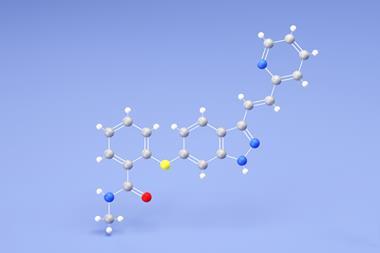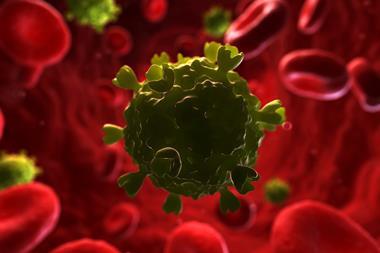Some medicinal chemists have changed their focus from proteins to target RNA, finds Rachel Brazil
The majority of drugs prescribed today target proteins, and medicinal chemists have built up decades of expertise in designing them. But there are a small number of important drug molecules that target RNA. The first double blind clinical trial in 1946 was for streptomycin, an antibiotic that targets bacterial RNA. ‘That took people who had tuberculosis out of the sanitarium,’ says chemist Matthew Disney from Scripps Research in Florida, US. Today, RNA-targeting drugs are again on the agenda, now also seeking human RNA targets. Oligonucleotide drugs are leading the way, but chemists are also now pursuing small molecule approaches, opening up new avenues to RNA therapeutics.
Our once-simple model of DNA being transcribed in RNA which is translated into proteins has been replaced by a more complex understanding of RNA’s role in biology. Several types of non-coding forms are produced to regulate gene expression and this provides a multiplicity of new drug targets that in fact outnumber the protein targets available. ‘RNA is upstream of all biology,’ says Jennifer Petter, chief scientific officer of Arrakis Therapeutics in Massachusetts, US. This makes it an attractive target: ‘Then you have the opportunity to go after all diseases.’
‘For the past hundred years or so we’ve been quite focused on proteins,’ says Petter. ‘There really hasn’t been that much work on [RNA].’ This is partly due to the difficulty in elucidating the structure of RNA molecules to design drugs that can bind to it. ‘For proteins, you more often have crystal structures, so structure-based design is possible,’ explains chemist Maria Duca from the University of Côte d’Azur in France. ‘For RNA, often you do not have that because the structures are less stable.’
Single or double?
Advances in sequencing have led to a different approach. Over the last few decades, RNA therapeutic development has largely involved oligonucleotides – with RNA itself becoming a drug molecule. Development took off in the early 2000s with huge amounts of investment, but progressed slowly until recently. Now the field seems back on track with at least 431 RNA-targeting drug development programmes, and nine oligonucleotide drugs approved by the FDA so far.
There are two main approaches – the first being antisense oligonucleotides (ASO), which uses a single strand of RNA, complementary to the target messenger RNA molecule, in a similar manner to the natural process by which micro RNA molecules function. By base-pairing, the RNA is unable to be translated and the molecule will eventually be destroyed by nucleases, down-regulating the target gene. The other approach takes advantage of the RNA interference (RNAi) pathway. Alnylam Pharmaceutical, founded in 2002, has been a pioneer in using RNAi, and has delivered the first three therapeutics based on this mechanism.
RNAi is a biological mechanism designed to regulate gene expression, using small interfering RNA (siRNA) – double-stranded non-coding RNA molecules. ‘It’s just an incredible mechanism,’ says Klaus Charisse, vice-president of research at Alnylam. The double-stranded RNA molecules are loaded into a complex of proteins known as a Risc (RNA-induced silencing complex) where they are unwound and one strand, the antisense strand, is retained. The Risc scans for complementary messenger RNA, which are bound and degraded. If siRNA drug molecules can be delivered into cells, they can also take advantage of this natural mechanism and the catalytic nature of the Risc means that, once loaded, an siRNA can stay there and function for months.
Delivery, delivery, delivery
While there is ongoing development of both ASOs and RNAi drugs, siRNA drugs have some advantages according to Marie Lindholm, currently head of molecular design at Silence Therapeutics, based in London, UK. ‘Because it is double stranded [RNA], and it’s also quite big, it cannot get into cells unintentionally.’ In addition, double-stranded RNA is inherently more stable than the single strand, as most nucleases only degrade single-stranded RNA. But all these advantages are meaningless if the drug cannot be delivered into cells.
We only have three problems and they’re delivery, delivery, delivery
‘I remember very vividly our CEO, John Maraganore, coming into a meeting in 2003,’ recalls Charisse, ‘and he said “We only have three problems and they’re delivery, delivery, delivery”.’ One of the first approaches was to encapsulate siRNAs in lipid nanoparticles. ‘It worked well for some indications, but it didn’t work equally well for everything,’ says Lindholm.
Another method developed by Alnylam and now widely used is to transport siRNAs by conjugation to N-acetylgalactosamine (GalNAc), an amino sugar derivative of galactose, necessary for inter-cellular communication. A trimer of GalNAc binds to a cell receptor predominantly found on liver cells and this allows the conjugate to enter the cell, where a small fraction of the drug escapes into the cytoplasm to be loaded in a Risc. Of course, this approach is limited to proteins found in the liver but, as Charisse explains, ‘about 60% of our secreted proteins are made in hepatocytes [liver cells], [so] you have a high chance of finding [RNAs related to] many diseases in there’.
But RNA molecules need further chemical modification. ‘If we just take two strands of regular RNA … they would be degraded and lost within probably less than half an hour,’ says Lindholm. There are also risks that the immune system will recognise the RNA as foreign and trigger a response causing unwanted side effects. One modification, designed by chemists at Alnylam, is to incorporate alternating fluorine or methoxy groups on the ribose sugar at the 2′ position. ‘The OH group which you have at that position can [allow] hydrolysis,’ says Charisse. ‘By replacing this with a 2′ fluoro atom you get high metabolic stability.’ The exact positioning of substitutions along the RNA molecule is something the company does not reveal, however.
Another modification, also used for single strand ASOs, is to replace the RNA’s phospho-diester linkages with phosphorothioates on the extreme ends of each RNA strand – essentially replacing a non-bridging oxygen atom with one of sulfur. ‘They are much harder for the exonuclceases [enzymes that work by cleaving nucleotides one at a time] to jump through, and that increases [drug] activity,’ says Lindholm. Silence have started to add two sulfur atoms to prevent the formation of a chiral centre, so they do not end up with multiple isomers to purify after synthesis. ‘That makes identification and isolation so much easier,’ she explains, and the molecules retain their biological activity.
Small molecules return
But oligonucleotides are no longer the only game in town. Medicinal chemists, with help from their colleagues in chemical biology, are starting to hunt for small molecules that can drug RNA targets. The advantages of this approach is the oral delivery and bio-availability small molecules offer. The perceived difficulties have been overplayed according to Petter, whose Arrakis Therapeutics have joined the hunt. ‘I think there have been some prejudices about RNA because it is more dynamic than the average protein on the street. You have to be willing to kind of take that on and find molecules that will wrestle that RNA to the ground,’ she says.
2020 saw the approval of the first in a new generation of RNA targeting small molecule drugs. The drug risdiplam (sold as Evrysdi) was developed by Roche and biotech company PTC Therapeutics to treat the genetic condition spinal muscular atrophy (SMA) that progressively destroys motor neurons. Patients with SMA have mutations that prevent the formation of a protein, SMN, which is critical for maintaining healthy motor neurons. The unique mechanism of the drug allows more SMN to be formed from a patient’s remaining SMN gene by modifying how the initial RNA transcript (pre-messenger RNA) is spliced. The small molecule drug binds to a loop on the RNA, stabilising the correct assembly of enzymes needed to process the RNA so that it forms the SMN protein.1
There are a large number of RNAs, both coding and non-coding, that are very robustly folded
As with most drug discovery strategies, finding small molecules able to bind RNA usually starts with screening, especially in big pharma companies according to Duca. ‘They can screen millions and millions of compounds until they find something against the target.’ Duca herself has been carrying out more focused screening using compounds known to interact with RNA. One recent project identified polyamine derivatives as a promising starting point for binding a precursor of a micro RNA molecule (miRNA-372), whose disregulation is linked to gastric cancer.2 RNA will carry a negative charge, so positively charged polyamines will bind strongly, but not specifically, so ‘we found that [by] combining polyamines with other heteroaromatic compounds, [we were] able to bring some specificity to [the] binding’, explains Duca.
Arrakis Therapeutics is combining screening with a suite of chemical biology tools to develop their pipeline of RNA-targeted small molecule medicines.3 So far they haven’t had problems identifying ‘drug-like’ molecules – often described as ‘Lipinski compliant’. The Lipinski rules, formulated by Pfizer chemist Christopher Lipinski in 1997, describe the ideal orally administered drug molecule as small, moderately lipophilic, with less than five hydrogen bond donors and 10 hydrogen bond acceptors. ‘Our internal library and the libraries that we have screened externally have all been very [Lipinski] obedient,’ says Petter. ‘We have seen remarkable selectivity in our results, at least as good as the kind of selectivity you observe when you screen small molecules against proteins.’
Some of the most successful strategies in small molecule RNA drug discovery have come from the Disney lab. For the last 15 years the lab has been developing methods to take any RNA sequence and design a molecule that can bind to it and affect its function. ‘We know now that there are a large number of RNAs, both coding for protein and those that do not code for protein, that are very robustly folded’, says Disney. ‘[In] most cases, their function is a direct consequence of the folds that they adopt.’
In 2014 Disney began developing Informa – an informatics system that can anticipate binding strength and selectivity using a database of experimentally determined interactions between RNA-motifs and small molecules. ‘We developed a library versus library screening approach where we could, in a massively parallel fashion, interrogate molecular recognition between small molecules and RNA folds,’ explains Disney. Informa takes RNA sequences and folds them to look for comparable structures and small molecules that have been identified to bind to them. ‘It’s sequence-based drug design,’ says Disney. ‘It rapidly identifies lead chemical matter, with hypotheses about how specific and potent the molecules can be.’
It’s very difficult to get this done with small molecules
One big issue is actually making sure your small molecule is binding to an active site on the RNA molecule, says Disney. ‘You have to bind to a functional element, which could be a site that’s cleaved by a ribonuclease, it could be a structure in your start codon, or it could be a structure that regulates translation.’ Disney has developed a method to achieve this, through what he calls ribonuclease targeting chimeras (Ribotacs).
‘[Ribotacs] have small molecules that bind to RNA and then a second small molecule binding to and locally activating a ribonuclease to cleave the [RNA] target. And these things are catalytic and sub-stoichiometric,’ explains Disney. ‘We’ve been able to take Ribotacs and eliminate, in an animal, a messenger RNA that causes pretty debilitating genetic disease.’ In recent work the Disney group synthesised a Ribotac, designed to target microRNA-21, which is upregulated in some tumours. In a mouse model, the molecule was able to decrease the spread of metastatic breast cancer.4 Disney has also recently used the approach to target the RNA of the Sars-CoV-2 virus.5
Not everyone sees the advantages of a small molecule approach though. ‘I don’t see a very easy path forward,’ says Charisse. He argues the sequence-based specificity offered by RNAi is unbeatable. ‘It’s very difficult to get this done with small molecules.’ But Disney says small molecules can get into tissues that oligonucleotide drugs currently can’t, including cancer cells. Although Disney acknowledges there is a role for multiple approaches, ‘each individual technology is going to have a different disease setting that they’ll be best applied to. I’m not saying that one is going to be a panacea.’
There may still be a move away from the traditional small drug-like molecules that medicinal chemists usually focus on, Petter adds. ‘I would not be at all surprised to see the data push our searches into new directions; for example, directions that force us to be Lipinski non-compliant,’ she says. ‘The question is what chemical space binds RNA? I think that’s where we have no clue,’ says Disney. ‘There’s a cataclysmic gap between a Lipinski-occupying small molecule and an ASO. There’s a lot of space there that you can explore. I think we just need to come into this without preconceived notions about what an RNA targeting drug should look like.’
Modifying RNA
Rather than target RNA itself, biotech start-up Accent Therapeutics have been looking at another approach – drugging the enzymes that modify RNA molecules in cells. ‘All RNAs – messenger RNA, transfer RNA, ribosomal RNA – are all susceptible to a very wide diversity of modifications, covalent and non-covalent, and these modifications really impact just about every aspect of RNA biology,’ says Robert Copeland, co-founder of the Massachusetts-based company, set up in 2017. ‘This approach is a way to control RNA biology, not by targeting the RNA per se, but targeting the enzymes responsible for these modifications.’
Finding small molecule drugs to target the binding pockets of those enzymes means Accent and a number of other start-ups are able to use well-established drug discovery methods. ‘We see the approach that we’re taking as a marriage between the very exciting area of RNA biology with a very pragmatic approach to small molecule drug discovery … we know so much about how to do that, as a medicinal chemistry community,’ says Copeland.
There are tens of thousands of RNA targets out there
RNA-editing enzymes selectively change an RNA nucleotide so that the meaning of its codon (the triplet nucleotide sequence corresponding to a specific amino acid) changes from one amino acid to another. ‘One of the targets we’re working on is an enzyme called ADAR1 which is an adenosine deaminase. It converts [the base] adenosine into inosine. [When translated] inosine is read not as adenosine, but as guanine, and so that changes codon usage and therefore, protein sequence,’ says Copeland. Adenosine-to-inosine (A-to-I) editing is one of the most prevalent mechanisms for RNA modifications in biology but it is also over-expressed in some cancer cells. The mechanism has been hijacked to promote cancer progression by editing RNA molecules, so that they are no longer able to stimulate the immune response needed to kill tumour cells. Accent are currently optimising drug candidates that inhibit ADAR1 and they hope to start clinical trials in the next couple of years.6
So far the company has a portfolio of five RNA-editing enzymes whose inhibition could be the basis of well-tolerated and easy to administer oral cancer therapies. But Copeland adds that the potential of targeting RNA-editing enzymes goes well beyond cancer and could include inflammatory diseases, immunological diseases and even infectious diseases. ‘We’re just starting to scratch the surface,’ he says.
In the meantime more RNA-targeting oligonucleotide drugs are likely to arrive on the market in the next few years. Alnylam are advancing a deep pipeline of siRNA-based medicines. ‘It is going to become huge, I almost guarantee it,’ says Charrise. The field so far is missing a big blockbuster drug that would turn heads, but it may be on the way. In 2020 Novartis acquired Alnylam’s cholesterol lowering siRNA therapy, inclisiran (marketed as Leqvio), which has now received approval in Europe. The siRNA drug is able to prevent the formation of a protein responsible for increasing the unhealthy form of cholesterol in the blood, and needs only two doses a year due to the long-lasting action of RNAi.
Arrakis Therapeutics expect to move their small molecule candidates into toxicology studies by 2022 to prepare for clinical trials. While they may be further behind their oligonucleotide colleagues, drugging RNA with small molecules will bring rich rewards, assures Petter, once the rules for targeting RNA become clearer. ‘There are tens of thousands of [RNA] targets out there, many more than there are at the protein level, so I think that the [drug discovery] landscape is ready for us.’
Rachel Brazil is a science writer in London, UK
References
1 S Campagne et al, Nat. Chem. Biol., 2019, 15, 1191 (DOI: 10.1038/s41589-019-0384-5)
2 C Staedel et al, Sci. Rep., 2018, 8, 1667 (DOI: 10.1038/s41598-018-20053-5)
3 H Mukherjee et al, ACS Chem. Biol., 2020, 15, 2374 (DOI: 10.1021/acschembio.0c00357)
4 M G Costales et al, Proc. Natl Acad. Sci. USA, 2020, 117, 2406 (DOI: 10.1073/pnas.1914286117)
5 H S Haniff et al, ACS Cent. Sci., 2020, 6, 1713 (DOI: 10.1021/acscentsci.0c00984)
6 P A Boriack-Sjodin, S Ribich and R A Copeland, Nat. Rev. Drug Discov., 2018, 17, 435 (DOI: 10.1038/nrd.2018.71)
Additional information














No comments yet